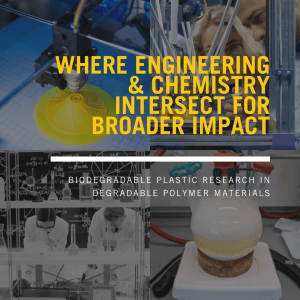In the Hunter and Stephanie Hunt Institute for Engineering and Humanity’s Global Development Lab, our interdisciplinary teams made up of students, fellows, faculty, and industry professionals are working to create meaningful solutions to promote resilient humanity, all of which address the UN Sustainable Development Goals (SDGs). The Where Engineering & Chemistry Intersect for Broader Impact report addresses biodegradable plastics where engineering and chemistry intersect.
Currently, many biodegradable products in the market are bio-based, such as polysaccharides, proteins, and lipids, and are focused on conventional plastic applications. This approach to the production of biodegradable plastics, however, is facing mounting challenges due to high cost, weaker performance, and environmental issues. Additionally, several biodegradable plastics have proven to break down quickly under specific, simulated environmental conditions, but they may not be effectively degradable under natural conditions. As a result of these challenges and many alike, there is a gap in the market.
As our Project Affiliates, Dr. David Son and Dr. Paul Krueger are investigating a prototype plastic that has predictable degradation and mechanical properties, in order to bridge this gap. In the spirit of interdisciplinary innovation, they seek to develop a joint chemical and engineering approach to biodegradable plastics for broader impact.
Dr. Son says, “As a chemist, I have the capability and knowledge to design a material from the molecular level up. It’s a challenge to synthesize a material with the ‘right’ properties. You can prepare a material cheaply, but it may not degrade. Or you can make a material that degrades too quickly or is not 3D-printable. In today’s world, the plastics disposal problem is not going away anytime soon, and it is exciting that Professor Krueger and our labs can help make a difference.”
Dr. Krueger says, “Material properties are important for durability and functionality of engineered systems. But they are also important for what happens when you are finished using the system. Having materials that can fulfill their design role as well as existing materials and can also easily degrade to facilitate future disposal is extremely valuable, but difficult to achieve. It’s a pleasure working with Prof. Son to achieve this dream and help to reduce plastic waste.”
There are many uses for biodegradable plastics to address our current state of plastics pollution. One potential future application could be biodegradable plastic used in combination with 3-D printing technology specifically designed for use with the unique geometric properties of the biodegradable prototype plastic. Compatibility with 3D printing methods would help to facilitate biodegradable plastic’s replacement of other less desirable materials, especially given its rapidly growing adoption and application for manufacturing both prototype and production components. The lab is developing a 3D printing technology (extrude and cure additive manufacturing, or ECAM) that can simultaneously print and cure thermoset polymers such as those considered in this project.
Another significant opportunity for the biodegradable plastic industry is an application towards alleviating medical waste. Focusing on producing better-quality medical supplies and reducing the end-of-life waste associated with such products, this application works towards the third UN SDG “to ensure healthy lives and promote wellbeing for all at all ages,” as well as the fourteenth UN SDG, which aims “to conserve and sustainably use the oceans, seas, and marine resources”[1].
In order to address this challenge, our team of multidisciplinary students and subject matter experts has been working diligently to develop biodegradable plastic with more desirable characteristics and predictable degradation properties. Through this research, they hope to address medical waste and produce a product that could potentially be used in 3D printing. A portion of the report provides a market analysis of biodegradable plastics, a discussion of their applications, and updates from the lab’s progress in their research.
Both the Son and Krueger labs continue to research a biodegradable plastic that is comparable in function and cost to the industry standard while achieving alternatives to traditional disposal and decomposition. Continue to read the Hunt Institute Digest for more information about this project and others like it.
Undergraduate Project Managers: Sydney Lobato and Taylor Grace
Undergraduate Research Analyst: Katherine Nguyen
Undergraduate Lab Researchers: Son Lab: Anderson Wey and Jamie Hall; Krueger Lab: Sami Streb
Global Development Lab Portfolio Manager: Corrie A. Harris, M.A., MBA
Hunt Institute Affiliates: Dr. David Son and Dr. Paul Krueger
[1] Oceans – United Nations Sustainable Development. (n.d.). Retrieved 2020, from https://www.un.org/sustainabledevelopment/oceans/
To read more about the Hunt Institute’s work to develop future-focused solutions to some of the world’s biggest problems, please click here. For the latest news on the Hunt Institute, follow our social media accounts on LinkedIn, Facebook, Twitter, and Instagram. We invite you to listen to our Podcast called Sages & Seekers. If you are considering engaging with the institute, you can donate, or sign-up for our newsletter by emailing huntinstitute@smu.edu.







